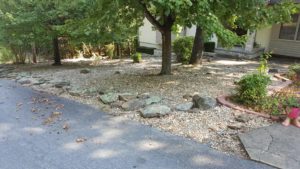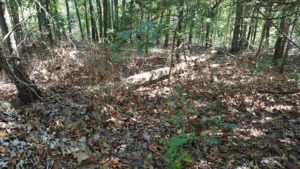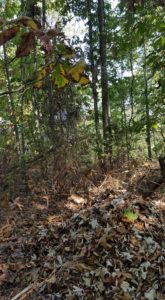
We live in a mostly forested area. The hills of Bella Vista, they tell us, were once cleared to allow for cattle grazing. However, once the land was bought up for residential properties (seen as a retirement community), the forest came back. If a lot is vacant, the forest will soon take over.
The part of Bella Vista I live in is mostly unbuilt. The hills are steep; building is expensive; the space between lots, back to back, is enormous. Hence, even if every lot were built on, the forest would be in the gullies behind. From our back lot line to the back lot line on the other side of the gully is probably 800 feet. No one’s built on those lots yet, so we look out our back deck onto endless forest and hills.

On our street, only four lots out of about 28 have been built on. South of us are three empty lots before the next house. North of us is one lot before another house. Across from us…well, there are no houses on the other side of the street at all. So we are surrounded by forest.
On the lot north of us, about 50 feet from our lot line, a large tree fell over about 10 years ago, a tree maybe 60 inches in caliper (20 inches diameter). I should say that the whole area has mostly second growth forests due to the prior clearing. Or, maybe it’s just how the soil is. It’s very thin topsoil due to the steepness of the slopes. Rocky. Not the type of soil you did in to plant a tree. So the trees grow easily, but never develop strong roots. The average life of a tree in these parts is probably 20 to 30 years. Then, a good windstorm will knock it over, and the saplings will grow and take it’s place. This is what happens all around us, and the woods are littered with deadfall, typically trees not even 8-inches diameter.
But, occasionally, a tree will be able to take root and live to a good age. We have a few older ones, especially along the route the old county road followed before the developer moved in. This old tree lived to well over 60 years, I reckon. But when it fell, it left a crater behind—not from the impact of falling, but from where the roots had been. A hole maybe four feet deep and eight feet across, on the slope, with the tree roots and soil between them up in the air.

So what will happen to this small tree crater in a world without human activity? Rainwater will collect in it, reducing the run-off down the slope, reducing erosion. Slowly the dirt will detach from the roots and fall to the ground, making a sort of dam on the downhill side, where the tree fell. This will further reduce run-off. Forest animals will have a source of water as the area dries between rains. The crater will be a leaf catcher, and slowly fill in. The tree trunk will rot away, giving habitat for snakes, bugs, even smaller bugs, and who knows what. With that large of a trunk, it will be around a long time. In the crater and near the downed trunk will be a good place for new trees to get their start. One last thing: The hole in the leaf canopy left by the tree has resulted in more light getting through to the forest floor, and much more underbrush is growing in this area.
But, enter mankind—me. My first thought when the tree fell was: Firewood! However, sawing a 20-inch oak trunk is no fun, even if you had a chainsaw. Plus, I don’t have a wood fireplace and hence have no place to burn, except maybe in a fire pit, which I don’t have at present. So, I let the trunk stay. When a new neighbor moved to the house on the other side of the lot, several years after it had fallen, he asked me if I had any claim on the tree, because he would sure like to cut it up. I told him it was his, but he never has.
The thing I am doing, however, is disposing of leaves in the crater. We have two maples and one oak in our front yard, and thus have many leaves to take care of in the fall. I blow them downhill until the piles are too large to blow, at which time I pick them up and move them to the woods. A few years back my wife suggested we not just dump them right next to the yard, but move them aways into the woods to reduce the chance they’ll blow right back on us. This sounded like work to me, but not a bad idea, so the leaves go off into the woods: about 150 feet on the lot to the south, or 50 feet on the lot to the north, right to where the downed tree is.
For the last four years I’ve been taking the leaves to the crater and dumping them in it. One Saturday I’ll fill the crater to overflowing. The next Saturday they will have settled under their own weight, and I’ll fill it to overflowing again. Week after week, for two months, I fill the crater. Now, after four years of this, the crater is pretty much gone, filled in by man, accelerating the natural process. At the height of leaf removal season, the crater is so filled I dump lots of leaves right around it, on the underbrush. Once I started doing this, the underbrush doesn’t grow as much as it did for a few years, having less access to sunlight.
Obviously, I’m causing the crater to fill in faster than natural processes would. Those leaves are being converted to new soil, year after year. This year, or perhaps next, I will declare the crater filled. No more water catching. No more water source for forest critters between rains. Less underbrush creating root structure to hold the soil in place.
In other words, my leaf depositing is speeding up natural processes. It seems to me I’m not doing anything worse than that. The forest will be essentially unchanged years from now when I lay down my leaf blower and rake. A few critters may have to look elsewhere for water. Thus their contribution to the local ecology will be reduced. We’ll see less deer and chipmunks.
All in all, this aging environmentalist doesn’t really see a problem with his ecology-changing activities. I hope I’m not overlooking something. Maybe someday, I’ll figure out how to make a book or story about this.